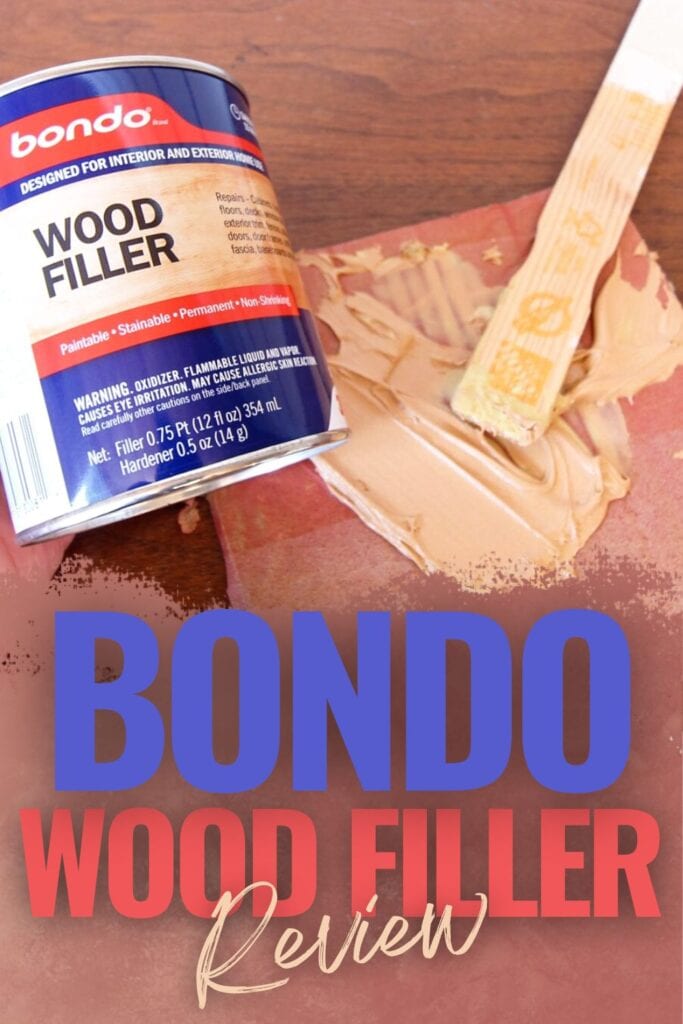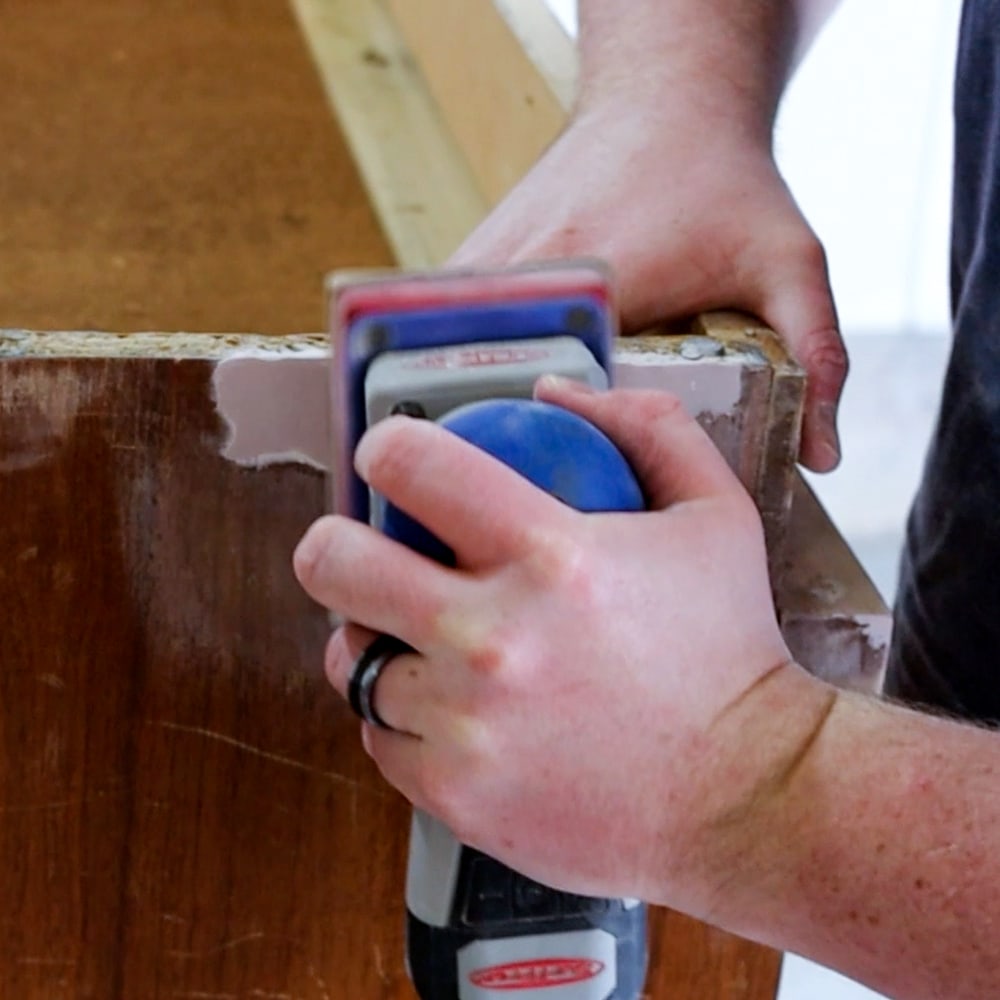Bondo Wood Filler Review
Today, let’s dive into the world of wood furniture repair, specifically focusing on a handy companion that’s been making waves – here’s our Bondo Wood Filler Review for when it comes to repairing old furniture. If you’ve ever been faced with scratched, dented, dog chewed or chipped wooden furniture, you know the struggle.
We’ll be taking a close look at this product, designed to repair and bring life back into your cherished items. We’ll go through its pros and cons, compare it with similar products, and even share some personal experiences. So, let’s roll up our sleeves and get started!

Whether you are a professional carpenter or a DIYer, having the right tools at your disposal is crucial, and Bondo Wood Filler can be one of those essential tools. Especially if you are passionate about restoring and repairing furniture, this product could be a game-changer for you.
It’s designed to address a variety of issues, including dented, chewed, or chipped furniture, and it can definitely help you transform an old piece into something beautiful again.
In this review, we’re going to explore all the nitty-gritty details of Bondo Wood Filler, so you can make an informed decision about whether it’s right for your furniture repair needs.
As an Amazon Associate, I earn from qualifying purchases. I also may earn from other qualifying purchases with other companies or get free product to review and use. All opinions are my own.
Basics of Furniture Repair
Before we dive into the specifics of the Bondo Wood Filler, let’s take a moment to consider the importance of furniture repair. The pieces of furniture that adorn our homes or offices aren’t just functional objects; they are expressions of our personal style and taste.
Over time, the continuous use, and sometimes misuse, of these items can lead to various damages, such as chipped wood, missing veneer, holes from repurposing, or simply wear and tear.

While it may seem easier to replace damaged furniture, restoring them has its charm and advantages. Repairing your furniture not only breathes new life into your cherished items but also reduces waste, making it a greener option.
Plus, it often proves to be a more cost-effective solution. However, furniture repair requires patience, attention to detail, and the right tools and materials.
That’s where products like Bondo Wood Filler come into play. Offering a durable and easy-to-use solution, it can be a game-changer for both professionals and DIYers.
But if you would like to try other wood fillers other than Bondo, you can check out our blog post about the best wood fillers for furniture here. We have also listed the best wood repair putty here that we have personally used in our projects.
Pros and Cons of Bondo Wood Filler
Every product has its strengths and weaknesses, and Bondo Wood Filler is no exception.
One of the standout advantages of Bondo Wood Filler is that it dries incredibly fast and hard, making it highly durable for all types of furniture repairs. It doesn’t crack under pressure, creating longevity of your repair work.
Its thin consistency makes it easy to spread over damaged areas and it’s simple to build up layers for deeper repairs.

On the flip side, the very feature that makes Bondo Wood Filler a favorite among many – its quick-drying nature – can also be a downside. You need to work swiftly to spread the filler before it begins to harden.
It also has a very strong odor, so it needs to be used in only well ventilated areas. Additionally, you need to mix the base and the hardener before use, which might be a bit of a hassle for some.
Pros
- It dries super fast, so you can keep your repair project moving without any unnecessary wait time.
- It’s durable as heck and won’t crack or shrink over time, so the fixes you make will last.
- Applying it is a breeze – it’s got a thin consistency that spreads easily for precise application. Plus, you can build it up to fill bigger dents or holes.
- It’s versatile and can handle all sorts of furniture repairs, perfect for any DIY enthusiast’s toolbox.
- And the best part? It’s economical! You only need a small amount for most repairs, so it’s great value for money.
Cons
- The fast drying time can also be a downside – you’ve got to work fast after mixing it up, so be ready to spring into action!
- It is very stinky. Make sure you’re working in a well-ventilated area or you’ll end up with a noseful of strong odors.
- You need to mix the base and hardener together before using it – this isn’t the most convenient step, especially if you’re in a hurry.
- Once it’s hardened, it might be a little tough to sand down, especially for those who aren’t too familiar with such tasks. So, patience and a bit of elbow grease will be required.
Using Bondo Wood Filler for Furniture Repair
Using Bondo Wood Filler for furniture repair is a straightforward process that even beginners can handle. Here is a step-by-step guide help you:
Before applying the Bondo Wood Filler, make sure the furniture surface is clean and free from dust or debris. Check out our blog post about cleaning furniture before painting to learn why cleaning furniture is important before painting.
Sand the area to be repaired with medium-grit sandpaper to create a rough surface for the filler to adhere to. Wipe away any dust with a damp cloth.
Learn more about why sanding before painting furniture is important and which is the best sandpaper for furniture painting to help you choose the right type of sandpaper for your project.
As mentioned before, the Bondo Wood Filler consists of a base and a hardener. These need to be mixed right before application. Scoop out a golf ball-sized amount of the base onto a scrap piece of wood or cardboard.

Then add a 3-4″ squeeze of the hardener. Keep mixing until you get a consistent color. Remember, you’re against the clock here, so work quickly!
With your spreader, scraper, or old gift card, apply the mixed filler to the damaged area. Spread it out evenly, making sure to overfill the area slightly. This overfilling allows you to sand it down to a smooth, flush finish once dry.
Bondo Wood Filler dries very fast. Within about 30 minutes, it should be hard and ready for sanding.
Once the filler is completely dry, use medium or fine-grit sandpaper (anywhere between 100 grit – 220 grit sandpaper) to sand down the surface until it’s smooth and flush with the surrounding wood. After sanding, clean the area, and your furniture repair is ready for painting or staining.
Here’s everything you need to know about Bondo wood repair for your furniture.
Check out how we repaired the vintage legs on this chalk painted nightstand makeover.

Remember, Bondo Wood Filler is extremely durable, but it’s also very tough once dry. So, take your time with the sanding to get the best results. Don’t forget to use it in a well-ventilated area because of the strong odor, and always wear protective gear for safety.
How Bondo Compares to Other Wood Fillers
When it comes to furniture repair, there are other alternatives to Bondo Wood Filler, such as KwikWood and Regular Wood Filler, that are also worth considering.
KwikWood, just like Bondo, is a two-part epoxy that sets hard and works great for filling gaps, holes, or replacing rotted wood. Plus, it’s super easy to shape, sand, drill, or paint.
Unlike Bondo though, KwikWood has a more putty-like consistency, which can make it easier to shape by hand in some situations, but maybe not as ideal for others. Oh, and KwikWood takes a bit longer to dry – about an hour compared to Bondo’s lightning-fast drying time.
Learn more about the detailed steps on how to use KwikWood here.
Regular Wood Filler, on the other hand, is a popular go-to for many DIYers. It’s a one-part product, meaning there’s no mixing needed, and it’s easy to smooth and shape.
However, Regular Wood Filler doesn’t offer the same level of durability as Bondo or KwikWood, and it can shrink and crack over time. It’s also no good for large repairs. It’s best for small scratches or dings on furniture.
Basically, each of these products has its own advantages and disadvantages. The best choice depends on the specifics of your repair project, how comfortable you are with the product, and your personal preferences.
Just remember to test a small amount of any product on a hidden area of your furniture before you start your repair work to make sure it’s the right fit.
Here’s a comparison of Bondo VS other wood fillers in filling holes when replacing cabinet or furniture hardware!
My Bondo Wood Filler Review
In my experience, Bondo Wood Filler is an excellent product for furniture repairs, especially when dealing with chipped veneer or larger, deep damages. I’ve used it on multiple occasions and it has never let me down.
Yes, the smell can be quite intense, which is why I strongly recommend using it outdoors or in a well-ventilated area. But that’s a small inconvenience considering how well it works.
In terms of performance, I’d say it’s top-notch. The filler dries real quick, gives a strong and long-lasting repair, and once you paint or stain it, it blends perfectly with the original wood. It’s like the damage was never even there!

Bondo really shines when it comes to ease of use. Although mixing the base and hardener can feel a bit rushed because it dries fast, the product’s consistency makes it super easy to apply and smooth out. I’d give it a solid 4 out of 5 for this.
When it comes to price, Bondo Wood Filler offers great bang for your buck. A little bit goes a long way, so even a small container can last you through many repairs.
Overall, I highly recommend Bondo Wood Filler for anyone in need of a strong, reliable, and budget-friendly solution for furniture repairs. It’s a handy product to have in your toolkit.
If you want more information on how I have used Bondo to fix our furniture, here is a small list of the tutorials I have use it on.
- How To Repair Damaged Furniture
- How To Repair Broken Trim On Furniture
- Repairing Veneer With Wood Filler
- How To Repair (And Stain) Chipped Veneer Furniture
- How To Change Hardware On A Dresser
Get the Secrets!
Grab this super convenient How to Repair Furniture Ebook with all of our secrets on how to repair furniture for only $14.
You can print it out and have instant access whenever you come across damaged furniture, and know exactly how to fix it!
Click on the picture of the book to purchase!
Whether you’re a seasoned DIYer or just starting out in furniture repair, Bondo Wood Filler is a must-have in your toolkit. It’s super resilient, dries quickly, and won’t break the bank – definitely stands out from the competition!
more Repairing Furniture Tips
- How to Fix a Chipped Wood Corner
- How to Repair Bubbled Veneer
- How To Fix A Missing Chunk Of Wood
- How To Fix Dog Chewed Wood Trim
- How To Repair Cracks In Antique Wood Furniture
Follow us on YouTube to get more tips for painting furniture.
Or share your project with us on our Facebook Group and be part of our community. See you there!


Hi-what is the difference between Bondo Auto Filler and Bondo Wood Filler? I think I see them interchangeably in your posts??
Thanks
Great question! They are very very similar and can be used interchangeably. The wood filler version is the color of natural wood, where as the Auto filler is is either blue or red or grey.